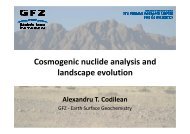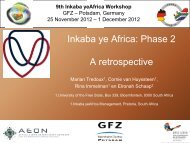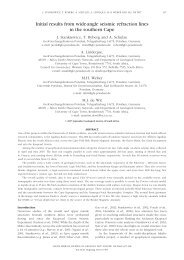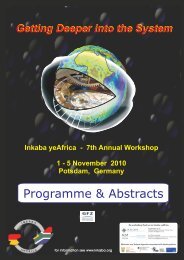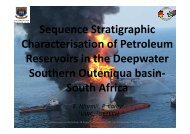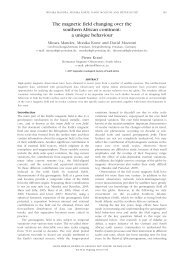South Africa - Inkaba.org
South Africa - Inkaba.org
South Africa - Inkaba.org
You also want an ePaper? Increase the reach of your titles
YUMPU automatically turns print PDFs into web optimized ePapers that Google loves.
Site characterisation:<br />
Astronomical seeing from a turbulence-resolving model<br />
M. Nickola 1,2 , I. Esau 3 , G.D. Djolov 2 , W.L. Combrinck 1 and R.C. Botha 1<br />
1. Hartebeesthoek Radio Astronomy Observatory (HartRAO) Space Geodesy programme, <strong>South</strong> <strong>Africa</strong>,<br />
marisa@hartrao.ac.za<br />
2. University of Pretoria (UP), Department of Geography, Geoinformatics and Meteorology, <strong>South</strong> <strong>Africa</strong>,<br />
ge<strong>org</strong>e.djolov@up.ac.za<br />
3. Nansen Environmental and Remote Sensing Center (NERSC), Bergen, Norway<br />
igor.ezau@nersc.no<br />
ABSTRACT<br />
A Lunar Laser Ranging (LLR) system is to form part of geodetic instrumentation to be located at a new<br />
fundamental space geodetic observatory for <strong>South</strong> <strong>Africa</strong>. LLR requires optical seeing (or astronomical seeing)<br />
conditions at ~ 1 arc second resolution level in order to deliver usable data. Site characterisation should include a<br />
description of astronomical seeing for various locations on-site as well as atmospheric conditions.<br />
Atmospheric turbulence degrades astronomical seeing. In-situ methods of determining astronomical seeing are<br />
difficult, time-consuming and costly. We propose the use of a turbulence-resolving model to determine and predict<br />
astronomical seeing at a site.<br />
Large Eddy Simulation NERSC (Nansen Environmental and Remote Sensing Centre) Improved Code (LESNIC) is<br />
a turbulence-resolving simulation code with which to model atmospheric turbulence. It has been used to compile a<br />
database of turbulence-resolving simulations, referred to as DATABASE64. This database consists of a collection<br />
of LESNIC runs for a stably stratified planetary boundary layer (SBL) over a homogeneous aerodynamically rough<br />
surface.<br />
Results from DATABASE64 for the nocturnal boundary layer are employed to render profiles of the vertical<br />
C profiles). Seeing parameter values are also obtained by making use of<br />
2<br />
distribution of optical turbulence ( N<br />
2<br />
DATABASE64 results. The C profiles and seeing parameters values obtained from DATABASE64 results are<br />
N<br />
compared with observational results that have been published in the literature. These values obtained are<br />
consistent with results from field campaigns as reported in the literature.<br />
Turbulence-resolving models, such as LESNIC, show potential for delivering and predicting profiles and<br />
parameters to characterise astronomical seeing, which are essential prerequisites for establishing an LLR system at<br />
the most suitable site and most suitable on-site location.<br />
KEYWORDS: astronomical seeing, atmospheric turbulence, LESNIC, LLR.<br />
63



